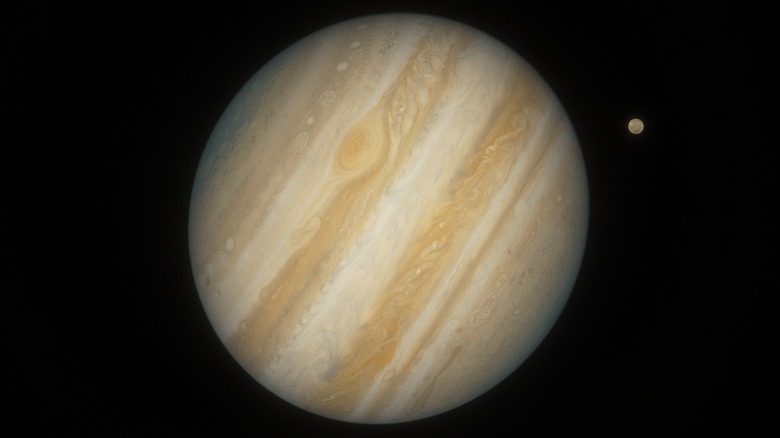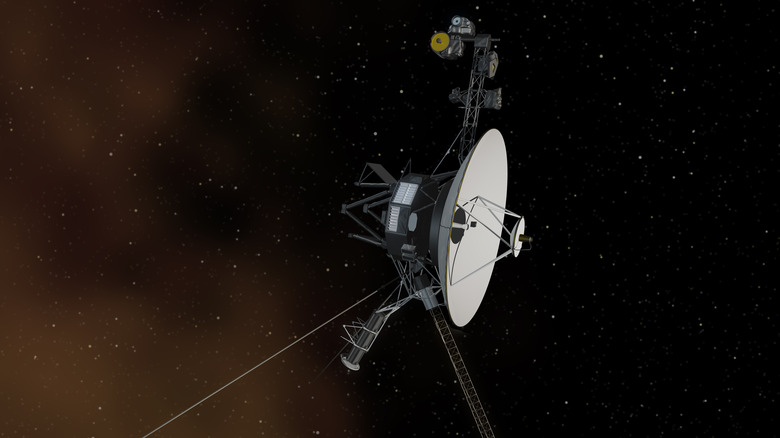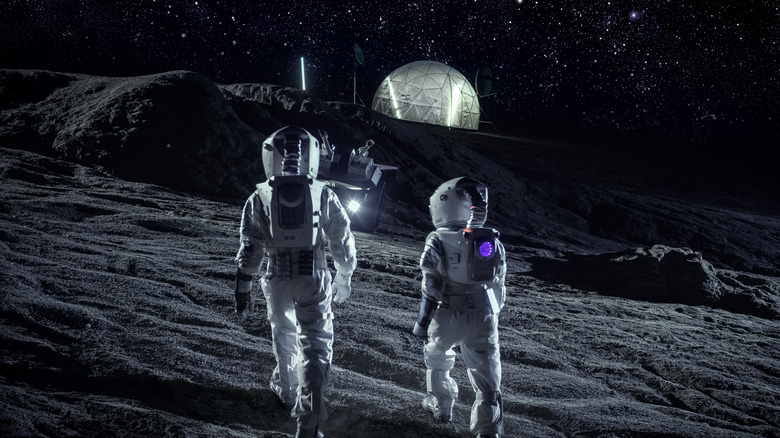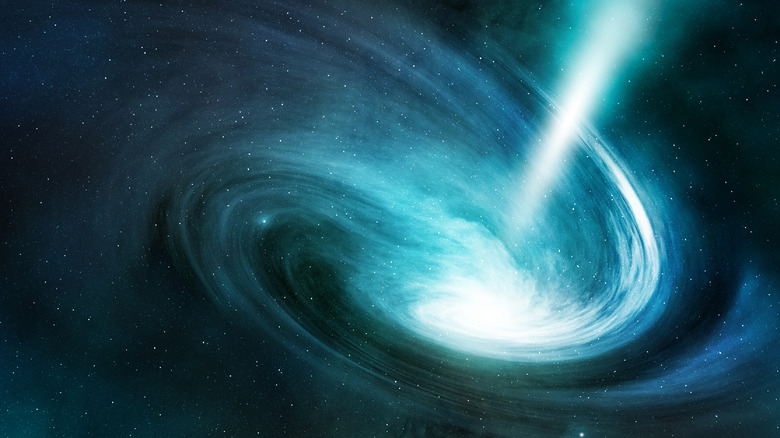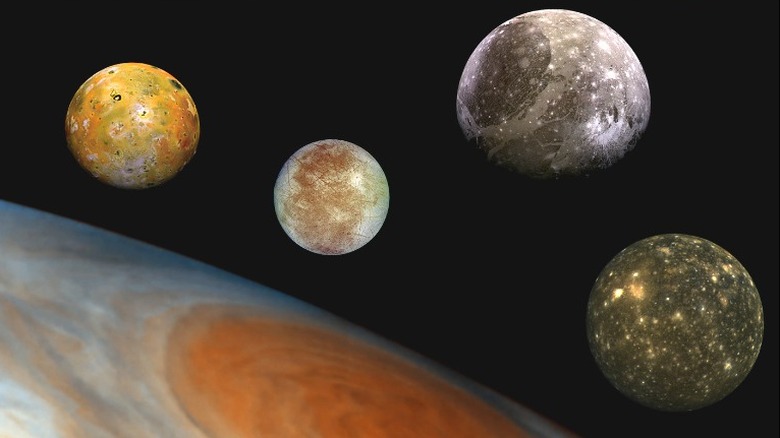How Long Would It Take For Humans To Travel To Jupiter?
The five visible planets have been central to human mythology for thousands of years and, along with the sun and moon, may be the reason we have seven days in a week (via Time and Date). And among the seven non-fixed bodies of the heavens, Jupiter has long been considered the king of them all. Today, Jupiter retains its status of King of the Planets due to its massive size: excluding the sun, it's twice as big as the rest of the solar system put together (from NASA).
Because of the prominence we've placed on it, humans have been observing and studying Jupiter for over 2,000 years (per Nature). Early in the 17th century, Galileo Galilei's discovery of moons orbiting the planet upended the worldview that all objects in the solar system orbit the earth, and helped cement Nicolaus Copernicus' ideas about heliocentrism (via The Planetary Society).
Today, not satisfied to merely peer through our telescopes, we send probes to Jupiter to make close observations in our stead. But how long will it be before we can go there ourselves? And how long will it take us to get there when we do?
The long and winding road
If we want to know how long it's going to take to travel to Jupiter, we need to know how far away it is. Because both the Earth and Jupiter are constantly moving, the answer is always changing. The closest the two planets can possibly be is 365 million miles, with a maximum of 601 million miles (via Space.com). Just for perspective, 601 million miles is over 24,000 times the girth of the Earth. So, if you wanted to drive the shortest possible route going 70 mph the whole way, it would take you just under 600 years to do it, or 979 years if you take the scenic route.
But let's be real. We're not driving to Jupiter, and not just because there are no gas stations along the way. If we're going to travel to another heavenly body we're going to need a spaceship of some kind. How fast do those go? The fastest humans have ever traveled is 24,800 mph on the Apollo 10 mission. If we could travel at that speed for the whole trip it would take between 613 days and 1,009 days, depending on the position of the planets.
Past precedent
But what about spacecraft that have actually been to Jupiter? In the 1970s, four separate probes were sent: Pioneers 10 and 11, and Voyagers 1 and 2. All four probes took a direct route to our largest planetary companion and so spent anywhere from 546 to 688 days in transit. The record is held by the New Horizons probe, which traveled between 36,000 and 47,000 mph on its trip to Jupiter (via University of Maine at Presque Isle), reaching the planet in 405 days before continuing on toward Pluto.
Although all of these probes managed to reach Jupiter, none of them stuck around. The Voyager probes have left the solar system (via Space.com) and New Horizons is moseying about in the Kuiper Belt (via Space Center Houston). Only two spacecraft have ever traveled to Jupiter and stayed there: Galileo and Juno. Both probes took a more circuitous route to get to Jupiter, using the gravitational pull of the inner planets to gain the speed required to launch past the asteroid belt and into Jupiter's orbit. Taking the long way means you use less fuel on the trip, fuel which is needed to slow down enough to achieve a stable orbit (via ScienceABC). So how long did these trips take? Galileo clocked in at just over six years, and Juno managed to do it in a bit under five.
Human exploration
The extent of our manned forays into outer space have reached no farther than the moon. Our last trip there was in 1972 but we hope to be back there by 2025 (at the soonest) on the Artemis 3 mission, which should take about three days (per Royal Museums Greenwich) to travel to the moon. NASA's explicit plan is to use these missions as a foundation on which to build missions to Mars in the 2030s.
According to NASA, the simplest, fuel-efficient route to Mars would take nine months for a one-way trip, and 21 months to go round trip. If we extrapolate the methodology used to calculate this route, a similar trip to Jupiter would take around three years just for the one-way trip. NASA also estimates that a four-person crew would need 8,000 pounds of food per year, meaning that a trip to Jupiter with four people would need to bring 48,000 pounds of food just to get there, and even more to make the return trip. Plus, the food would need to be launched into space from earth, as well as all of the life-support and scientific equipment. All of that weight will take longer to get up to speed and longer to slow down, increasing the potential timeline of the mission.
Here there be dragons
Supposing that weight is no object and we could potentially bring 100,000 pounds of food on an interplanetary odyssey to Jupiter and back, there's still the problem of getting there safely. Astronauts who leave the confines of the earth's gravity have a host of challenges to overcome. One of the most dangerous is radiation. Aside from the constant bombardment of radiation from the sun, unprotected by our magnetosphere, space travelers will have to protect themselves from a constant barrage of galactic cosmic rays which can lead to genetic damage and cancer (via Nature). It's even worse around Jupiter.
Spending lots of time in outer space also presents psychological challenges. Long-term space travel can lead to anxiety, worsening interactions with other crew members. Isolation from family and friends, along with a monotonous work schedule, only makes these symptoms worse. And these are problems faced by contemporary space travelers (via Clinical Neuropsychiatry, posted at the National Library of Medicine). We'll have to overcome these problems and new ones before we consider sending anyone to Mars, let alone Jupiter.
There are also physical risks. Space isn't empty, and when you're traveling at tens of thousands of miles per hour, even an impact with a grain of sand can be disastrous. And to get to Jupiter you'll have to cross the asteroid belt (via NASA).
Where would we even go?
One of the things that has always fascinated us about Jupiter is that it's a microcosm of the solar system. Just as myriad planets orbit the sun, so too does Jupiter have an entourage of heavenly bodies accompanying it on its voyage. Even though Jupiter is a gas giant with no solid surface on which to land a spacecraft, it does have 79 rocky moons which we could explore.
Four of those moons are substantially larger than the others, with gravity similar to our moon. The first three — Io, Europa, and Ganymede — are too close to Jupiter and receive too much radiation to allow humans on their surface without lots of protection. But the fourth moon, Callisto, receives significantly less radiation than the other three. It's also suspected that it has a subsurface ocean of liquid water which would make life much easier for any human visitors. (via Journal of the Washington Academy of Sciences).
In the early 2000s a study was done to assess the feasibility of a crewed mission to Callisto. It concluded that it wouldn't happen until at least the 2040s and it would require new kinds of propulsion that haven't been tested in space before. But, assuming everything falls into place, an eventual, round-trip mission could take anywhere between 652 and 1,661 days.
